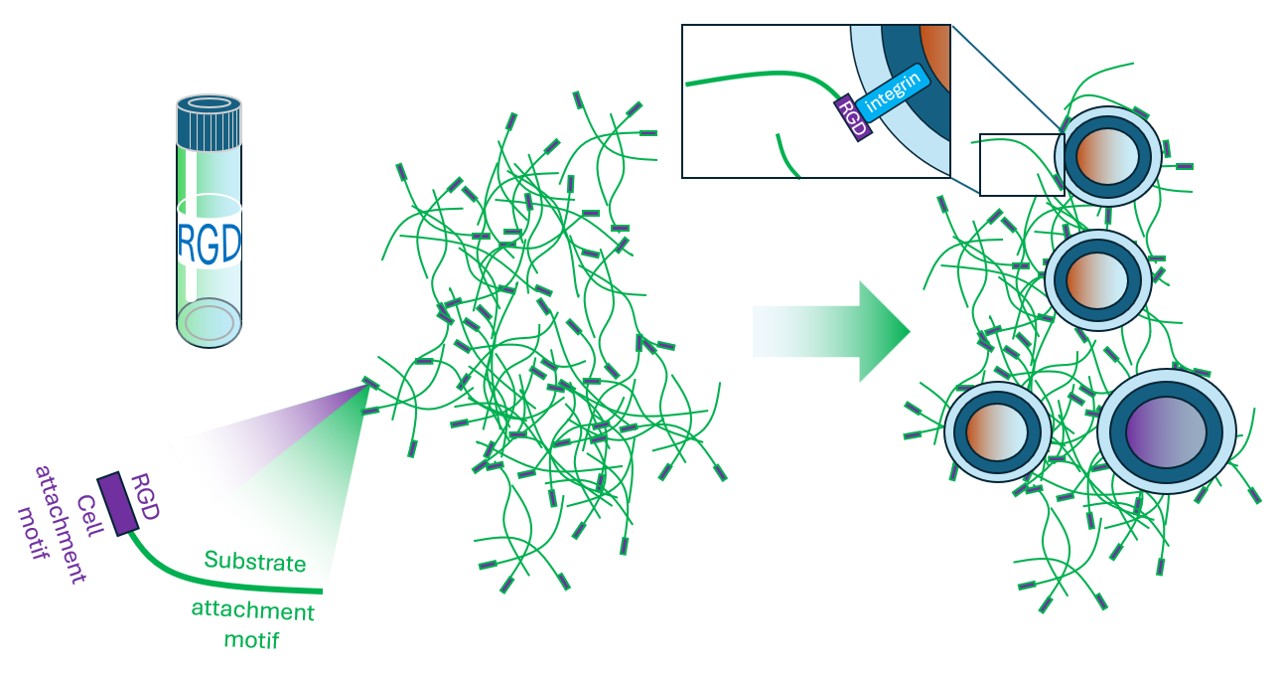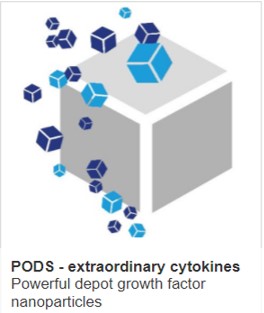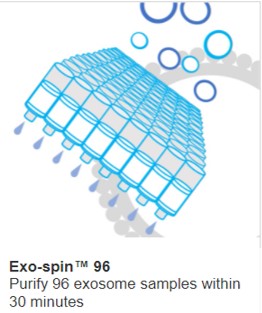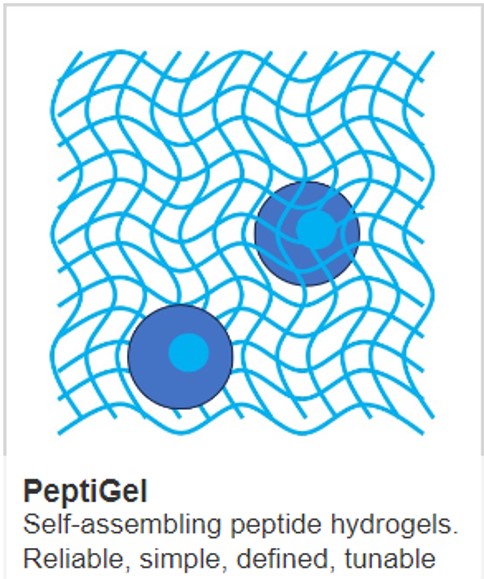The RGD Peptide, origins and applications

The RGD peptide (less commonly known as Arginylglycylaspartic acid), whose name is derived from the single letter code of the core amino acids, Arginine-Glycine-Aspartic acid, was first identified in the early 1980s by researchers studying cell adhesion. The discovery was significant because it revealed a common sequence in fibronectin, a major extracellular matrix protein, that facilitated cell attachment. This sequence, which is also found in other matrix proteins (vitronectin, von Willebrand factor, and thrombospondin), was later found to be a key recognition motif for integrins, a family of cell surface receptors that mediate cell-extracellular matrix (ECM) interactions.
Use of RGD Peptide
The RGD peptide has a wide range of applications in biomedical research and clinical settings:
Cell Adhesion Studies: RGD peptides are used to study cell adhesion mechanisms and integrin signalling pathways.
Tissue Engineering: They are incorporated into biomaterials to enhance cell attachment and proliferation, which is crucial for tissue engineering and regenerative medicine.
Drug Delivery: RGD peptides are used to target drugs to specific cells, particularly in cancer therapy, by exploiting the overexpression of certain integrins on tumor cells.
Wound Healing: They are used in wound dressings to promote cell migration and tissue repair.
Diagnostic Imaging: RGD peptides are conjugated with imaging agents to visualize tumors and other pathological conditions where integrins are overexpressed.
Anti-thrombosis: RGD peptides can inhibit platelet aggregation, making them useful in preventing blood clots.

RGD motifs are found in naturally occurring extracellular matrix proteins (ECM proteins). These RGD motifs bind to integrin receptor molecules on the surface of the cell. Synthetic RGD peptides also bind integrins. By adding a hydrophobic tail, RGD motifs are anchored to tissue culture surfaces improving cell adhesion IMAGE CREDIT Cell Guidance Systems
Types of RGD Peptides
There are multiple variations of RGD peptides, each designed to enhance specific properties or target particular integrins:
Linear RGD peptides are the simplest, most widely used form, consisting of the RGD sequence in a linear arrangement. They can be modified to enhance their functionality. The primary function of RGD is to support the adhesion of cells to surfaces. However, if the RGD peptide itself is not adequately anchored, it will not perform well. The RGD peptide available from Cell Guidance Systems has a 19 amino acid hydrophobic tail which enhances substrate binding to commonly used tissue culture surfaces such as glass and plastic.
Other types of RGD peptides include cyclic, multivalent, drug and chemical-conjugated.
In addition to the enhanced RGD peptide available from Cell Guidance Systems, other specific examples of RGD Peptides include.
RGDS: A simple linear peptide with the sequence Arg-Gly-Asp-Ser.
cRGD (Cyclo-RGD): A cyclic version of the RGD peptide, with enhanced stability and binding affinity.
RGD4C: A cyclic peptide with the sequence CDCRGDCFC, known for its high affinity for αvβ3 integrins, which are overexpressed in tumor vasculature. It is particularly used in cancer research and therapy.
RGD-K: An RGD peptide conjugated with a lysine residue, which can be further modified for various applications, such as attaching to nanoparticles or other therapeutic agents.
RGD-FITC: An RGD peptide conjugated with fluorescein isothiocyanate (FITC), used for imaging and tracking cell adhesion and migration.
RGD Applications in Research and Medicine
Cancer Therapy: RGD peptides are used to deliver chemotherapeutic agents directly to tumor cells, minimizing side effects and improving therapeutic efficacy. By targeting integrins that are overexpressed on tumor cells and their vasculature, RGD-conjugated drugs can achieve higher concentrations at the tumor site.
Angiogenesis Inhibition: RGD peptides can inhibit angiogenesis (the formation of new blood vessels) by blocking integrins involved in this process. This is particularly useful in treating cancers and other diseases characterized by abnormal blood vessel growth.
Tissue Engineering and Regenerative Medicine: RGD peptides are incorporated into biomaterials to promote cell adhesion, proliferation, and differentiation. This is crucial for the development of engineered tissues and organs. For example, RGD-modified scaffolds can enhance the integration of implanted materials with the host tissue.
Wound Healing: RGD peptides are used in wound dressings and hydrogels to promote cell migration and tissue repair. They can accelerate the healing process by enhancing the attachment and proliferation of skin cells.
Cardiovascular Applications: RGD peptides are used in cardiovascular research and therapy to promote the adhesion and growth of endothelial cells on vascular grafts and stents. This can improve the integration and functionality of these implants, reducing the risk of thrombosis and restenosis.
Bone Regeneration: RGD peptides are incorporated into bone graft materials to enhance the attachment and proliferation of osteoblasts, the cells responsible for bone formation. This can improve the outcomes of bone repair and regeneration procedures.
Neuroscience: RGD peptides are used to study neural cell adhesion and migration. They can also be incorporated into biomaterials designed for neural tissue engineering, promoting the growth and differentiation of neurons and glial cells.
Ophthalmology: RGD peptides are used in the development of treatments for eye diseases, such as age-related macular degeneration (AMD) and diabetic retinopathy. By targeting integrins involved in abnormal blood vessel growth, RGD peptides can help inhibit pathological angiogenesis in the eye.
Anti-thrombosis: RGD peptides can inhibit platelet aggregation by blocking integrins on the surface of platelets. This property makes them useful in the development of anti-thrombotic agents, which can prevent blood clots and reduce the risk of conditions such as stroke and myocardial infarction.
Diagnostic Imaging: RGD peptides conjugated with imaging agents (such as radioactive isotopes, fluorescent dyes, or magnetic nanoparticles) are used to visualize tumors and other pathological conditions. These targeted imaging agents can provide detailed information about the location and extent of disease, aiding in diagnosis and treatment planning.
Orthopedic Implants: RGD peptides are used to coat orthopedic implants, such as joint replacements and bone screws, to enhance their integration with the surrounding bone tissue. This can improve the stability and longevity of the implants.
Stem Cell Research: RGD peptides are used to study the adhesion, migration, and differentiation of stem cells. They can also be incorporated into scaffolds and hydrogels designed for stem cell-based therapies, promoting the growth and differentiation of stem cells into specific cell types.
IMAGE An integrin protein (green) binding to an RGD peptide (purple) CREDIT Lisa Slanino



